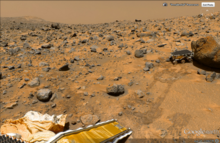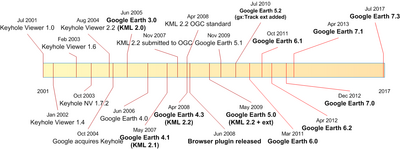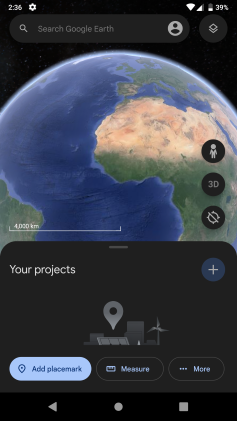
Requirements: BeeFree OS, md5 : a82e563ef6c984f6f379980b77ad679e, size : 63.3 MB
Google Earth is a computer program that renders a simulacrum of the Earth based on satellite imagery. It maps the Earth by the superimposition of images obtained from satellite imagery, aerial photography and geographic information system (GIS) onto a 3D globe.
It was originally an eponymous product sold by Keyhole, Inc. After Keyhole's acquisition by Google, Google Earth was released in June 2005,[5] driving public interest in geospatial technologies and applications. [6][7]
Google Earth displays satellite images of varying resolution of the Earth's surface, allowing users to see things like cities and houses looking perpendicularly down or at an oblique angle (see also bird's eye view). Imagery resolution ranges from 15 meters of resolution to 15 centimeters. Most areas in Google Earth are only shown in 2D aerial imagery, but for other parts of the surface, 3D images of terrain and buildings are available. Google Earth uses digital elevation model (DEM) data collected by NASA's Shuttle Radar Topography Mission (SRTM).[8] This means one can view almost the entire earth in three dimensions. Google Earth allows users to search for addresses for some countries, enter coordinates, or simply use the mouse to browse to a location.
Some people use the applications to add their own data, making them available through various sources, such as the Bulletin Board Systems (BBS) or blogs mentioned in the link section below. Google Earth is able to show various kinds of images overlaid on the surface of the earth and is also a Web Map Service client. Google Earth supports managing three-dimensional Geospatial data through Keyhole Markup Language (KML).[9]
Features
Wikipedia and Panoramio integration
In December 2006, Google Earth added a new integration with Wikipedia and Panoramio. For the Wikipedia layer, entries are scraped for coordinates via the Coord templates. There is also a community-layer from the project Wikipedia-World. More coordinates are used, different types are in the display and different languages are supported than the built-in Wikipedia layer.[10][11] The Panoramio layer features pictures uploaded by Panoramio users, placed in Google Earth based off user-provided location data. Google announced on May 30, 2007 that it is acquiring Panoramio.[12]Flight simulator
Downtown Toronto as seen from a F-16 Fighting Falcon during a simulated flight
Featured planes
- F-16 Fighting Falcon – A much higher speed and maximum altitude than the Cirrus SR-22, it has the ability to fly at a maximum speed of Mach 2, although a maximum speed of 1678 knots (3108 km/h) can be achieved. The take-off speed is 225 knots, the landing speed is 200 knots (370 km/h).
- Cirrus SR-22 – Although slower and with a lower maximum altitude, the SR-22 is much easier to handle and is preferred for up-close viewing of Google Earth's imagery. The take-off speed is 75 knots (139 km/h), the landing speed is 70 knots (130 km/h)[14]
Sky mode
Google Earth in Sky Viewing Mode
Google Sky faces competition[21] from Microsoft WorldWide Telescope (which runs only under the Microsoft Windows operating systems) and from Stellarium, a free open source planetarium that runs under Microsoft Windows, macOS, and Linux.
On March 13, 2008, Google made a web-based version[22] of Google Sky available via the internet.
Street View
On April 15, 2008 with version 4.3, Google fully integrated its Street View into Google Earth. Google Street View provides 360° panoramic street-level views and allows users to view parts of selected cities and their surrounding metropolitan areas at ground level. When it was launched on May 25, 2007 for Google Maps, only five cities were included. It has since expanded to more than 40 U.S. cities, and includes the suburbs of many, and in some cases, other nearby cities. Recent updates have now implemented Street View in most of the major cities of Canada, Mexico, Denmark, South Africa, Japan, Spain, Norway, Finland, Sweden, France, the UK, Republic of Ireland, the Netherlands, Italy, Switzerland, Portugal, Taiwan, and Singapore.Google Street View, when operated, displays photos that were previously taken by a camera mounted on an automobile, and can be navigated by using the mouse to click on photograph icons displayed on the screen in the user's direction of travel. Using these devices, the photos can be viewed in different sizes, from any direction, and from a variety of angles.
Water and ocean
Introduced in version 5.0 (February 2009), the Google Ocean feature allows users to zoom below the surface of the ocean and view the 3D bathymetry beneath the waves. Supporting over 20 content layers, it contains information from leading scientists and oceanographers.[23] On April 14, 2009, Google added underwater terrain data for the Great Lakes.[24][25]In June 2011, higher resolution of some deep ocean floor areas increased in focus from 1-kilometer grids to 100 meters thanks to a new synthesis of seafloor topography released through Google Earth.[26] The high-resolution features were developed by oceanographers at Columbia University's Lamont-Doherty Earth Observatory from scientific data collected on research cruises. The sharper focus is available for about 5 percent of the oceans (an area larger than North America). Underwater scenery can be seen of the Hudson Canyon off New York City, the Wini Seamount near Hawaii, and the sharp-edged 10,000-foot-high Mendocino Ridge off the U.S Pacific Coast. There is a Google 2011 Seafloor Tour for those interested in viewing ocean deep terrain.[27]
Historical Imagery
Introduced in version 5.0, Historical Imagery allows users to traverse back in time and study earlier stages of any place. Clicking the "clock" icon in the toolbar opens a time slider, which marks the time of available imagery from the past. This feature allows for observation of an area's changes over time.[28]Other bodies in the Solar System
A picture of Mars' landscape.
One of the lunar landers viewed in Google Moon
Liquid Galaxy
Liquid Galaxy is a cluster of computers running Google Earth creating an immersive experience. On September 30, 2010, Google made the configuration and schematics for their rigs public,[33] placing code and setup guides on the Liquid Galaxy wiki.[34]Liquid Galaxy has also been used as a panoramic photo viewer using KRpano, as well as a Google Street View viewer using Peruse-a-Rue[35] Peruse-a-Rue is a method for synchronizing multiple Maps API clients.[36]
3D Imagery
Countries with 3D coverage in Google Earth
In 2009, in a collaboration between Google and the Museo del Prado in Madrid, the museum selected 14 of its most important paintings to be photographed and displayed at the ultrahigh resolution of 14,000 megapixels inside the 3D version of the Prado in Google Earth and Google Maps.[41][42]
Traffic
Google Earth includes a feature that allows users to monitor traffic speeds in real-time. In 2007, Google began offering traffic data in real-time, based on information crowdsourced from the GPS-identified locations of cellular phone users.[43] In version 4.3 released on April 15, 2008, Google Street View was fully integrated into the program allowing the program to provide an on the street level view in many locations.[44]Versions and variations
Illustrates timeline of KML and Google Earth history
Google Earth running on Android
Google Earth Plus
Discontinued in December 2008, Google Earth Plus was a paid subscription upgrade to Google Earth that provided customers with the following features, most of which have become available in the free Google Earth.[50]- GPS integration: read tracks and waypoints from a GPS
device. A variety of third-party applications have been created which
provide this functionality using the basic version of Google Earth by
generating KML or KMZ files based on user-specified or user-recorded
waypoints. However, Google Earth Plus provides direct support for the Magellan and Garmin product lines, which together hold a large share of the GPS market.
The Linux version of the Google Earth Plus application does not include any GPS functionality. - Higher-resolution printing.
- Customer support via email.
- Data importer: read address points from CSV files; limited to 100 points/addresses. A feature allowing path and polygon annotations, which can be exported to KML, was formerly only available to Plus users, but was made free in version 4.0.2416.
- Higher data download speeds
Google Earth Pro
Google Earth Pro is a business-oriented upgrade to Google Earth, with features such as a movie maker and data importer. Up until late January 2015, it was available for $399/year, though Google decided to make it free to the public.[51][52] The Pro version includes add-on software such as:- Movie making.
- GIS data importer.
- Advanced printing modules.
- Radius and area measurements.
Google Earth Enterprise
Google Earth Enterprise is designed for use by organizations whose businesses could take advantage of the program's capabilities, for example by having a globe that holds company data available for anyone in that company.[55] As of March 20, 2015, Google has retired the Google Earth Enterprise product, with support ending March 22, 2017.[56]Google Earth Enterprise (GEE) allowed developers to build and host their own private maps and 3D globes. GEE Fusion, GEE Server and GEE Portable Server source code (470,000+ lines) will be published on GitHub under the Apache2 license in March 2017.[57]
Google Earth 9
Google Earth 9 is a version of Google Earth first released on 18 April 2017, having been in development for two years.[58] The main feature of this update was the launching of a new web version of Google Earth.[59] This version added the "Voyager" feature, whereby users can view a portal page containing guided tours led by scientists and documentarians.[60] The version also added an "I'm Feeling Lucky" button, represented by a die, which takes the user to a random location on earth along with showing them a "Knowledge Card" containing a short excerpt from the location's Wikipedia article.[60]Currently, the web version of Google Earth is only available for Google Chrome.[59]
Google Earth Plug-in
The Google Earth API was a free beta service, allowing users place a version of Google Earth into web pages. The API enabled sophisticated 3D map applications to be built.[61] At its unveiling at Google's 2008 I/O developer conference, the company showcased potential applications such as a game where the player controlled a milktruck atop a Google Earth surface.[62]The Google Earth API has been deprecated as of 15 December 2014 and remained supported until the 15th of December 2015.[63] Google Chrome ended support for the Netscape Plugin API (which the Google Earth API relies on) by the end of 2016.[64]
Google Earth Outreach
Google Earth Outreach is a charity program, through which Google promotes and donates to various non-profit organizations. Beginning in 2007, donations are often accompanied by layers featured in Google Earth, allowing users to view a non-profit's projects and goals by navigating to certain related locations.[65] Google Earth Outreach offers online training on using Google Earth and Google Maps for public education on issues affecting local regions or the entire globe. In June 2008, training was given to 20 indigenous tribes in the Amazon rainforest, such as the Suruí, to help them preserve their culture and raise awareness for the problem of deforestation.[66]People who create content for the public benefit sector can create KML files detailing their efforts to the Showcase Gallery, where content is posted in the categories of Global Development, Public Health, Environment and Science, Culture and Education, and Social Services. The program has been launched in 9 countries: US, UK, France, Italy, Germany, the Netherlands, Spain, Switzerland, and Brazil.
Non-profit organizations featured in Google Earth via the Outreach program include ARKive, the Global Heritage Fund, Greenpeace, WaterAid, and the World Wide Fund for Nature.
Controversy and criticism
The software has been criticized by a number of special interest groups, including national officials, as being an invasion of privacy and even posing a threat to national security. The typical argument is that the software provides information about military or other critical installations that could be used by terrorists.- Former President of India APJ Abdul Kalam expressed concern over the availability of high-resolution pictures of sensitive locations in India.[67] Google subsequently agreed to censor such sites.[68]
- The Indian Space Research Organisation said Google Earth poses a security threat to India, and seeks dialogue with Google officials.[69]
- The South Korean government expressed concern that the software offers images of the presidential palace and various military installations that could possibly be used by hostile neighbor North Korea.[70]
- In 2006, one user spotted a large topographical replica in a remote region of China. The model is a small-scale (1/500) version of the Karakoram Mountain Range, which is under the control of China but claimed by India. When later confirmed as a replica of this region, spectators began entertaining military implications.[71][72]
- In 2006, Google Earth began offering detailed images of classified areas in Israel. The images showed Israel Defense Forces bases, including secret Israeli Air Force facilities, Israel's Arrow missile defense system, military headquarters and Defense Ministry compound in Tel Aviv, a top-secret power station near Ashkelon, and the Negev Nuclear Research Center. Also shown was the alleged headquarters of the Mossad, Israel's foreign intelligence service, whose location is highly classified.[73][74]
- Operators of the Lucas Heights nuclear reactor in Sydney, New South Wales, Australia asked Google to censor high-resolution pictures of the facility.[75] However, they later withdrew the request.[76]
- In July 2007, it was reported that a new Chinese Navy Jin-class nuclear ballistic missile submarine was photographed at the Xiaopingdao Submarine Base south of Dalian.[77]
- Hamas and the al-Aqsa Martyrs' Brigades have reportedly used Google Earth to plan Qassam rocket attacks on Israel from Gaza (See: List of Qassam rocket attacks.)[78][79]
- The lone surviving gunman involved in the 2008 Mumbai attacks admitted to using Google Earth to familiarise himself with the locations of buildings used in the attacks.[80]
- Michael Finton, aka Talib Islam, used Google Earth in planning his attempted September 24, 2009, bombing of the Paul Findley Federal Building and the adjacent offices of Congressman Aaron Schock in Springfield, Illinois.[81]
- In 2009, Google superimposed old woodblock prints of maps from 18th and 19th century Japan over Japan today. These maps marked areas inhabited by the burakumin caste, who were considered "non-humans" for their "dirty" occupations, including leather tanning and butchery. Descendants of members of the burakumin caste still face discrimination today and many Japanese people feared that some would use these areas, labeled etamura (穢多村, translation: "village of an abundance of defilement""), to target current inhabitants of them. These maps are still visible on Google Earth, but with the label removed where necessary.[82]
Blurred out image of the Royal Stables in The Hague, Netherlands. This has since been partially lifted.
As a result of pressure from the United States government, the residence of the Vice President at Number One Observatory Circle was obscured through pixelization in Google Earth and Google Maps in 2006, but this restriction has since been lifted. The usefulness of this downgrade is questionable, as high-resolution photos and aerial surveys of the property are readily available on the Internet elsewhere.[87] Capitol Hill also used to be pixelized in this way. The Royal Stables in The Hague, Netherlands also used to be pixelized, and are still pixelized at high zoom levels.
Critics have expressed concern over the willingness of Google to cripple their dataset to cater to special interests, believing that intentionally obscuring any land goes against its stated goal of letting the user "point and zoom to any place on the planet that you want to explore".[88]
Late 2000s versions of Google Earth require a software component running in the background that will automatically download and install updates. Several users expressed concerns that there is not an easy way to disable this updater, as it runs without the permission of the user.[89]
In the academic realm increasing attention has been devoted to both Google Earth and its place in the development of digital globes more generally. In particular, the International Journal of Digital Earth[90] now features many articles evaluating and comparing the development Google Earth and its differences when compared to other professional, scientific and governmental platforms.
Elsewhere, in the Humanities and Social Sciences, Google Earth's role in the expansion of "earth observing media" has been examined. Leon Gurevitch in particular has examined the role of Google Earth in shaping a shared cultural consciousness regarding climate change and humanity's capacity to treat the earth as an engineerable object.[91] Gurevitch has described this interface between earth representation in Google Earth and a shared cultural imaginary of geo-engineering as "Google Warming".










